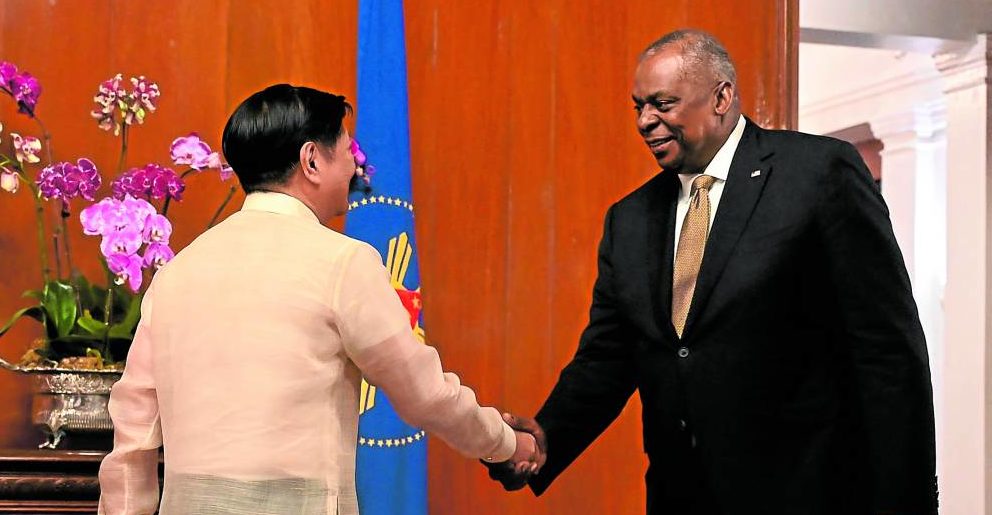
KEY ALLY US Defense Secretary Lloyd Austin III meets President Marcos at Malacañang on Thursday before Manila and Washington announced that US forces will be allowed access to four more Philippine military bases. Austin calls the Philippines a key and important ally of the United States. —REUTERS
The Philippines has granted the United States access to more of its military bases, the defense chiefs of both countries announced on Thursday, amid concerns over China’s continued assertiveness in the South China Sea and potential invasion of Taiwan.
The agreement by both countries to add four new locations “in strategic areas of the country” under the 2014 Enhanced Defense Cooperation Agreement (Edca) capped the visit to Manila by US Defense Secretary Lloyd Austin III, who arrived Tuesday night.
Austin held talks with President Marcos at Malacañang before meeting acting Defense Secretary Carlito Galvez Jr. and Foreign Secretary Enrique Manalo.
“From defense perspective,” he told the President, “we will continue to work together with our great partners and to build and modernize your capabilities as well as increase our interoperability.”
Mr. Marcos thanked Austin for visiting the Philippines amid a “terribly complicated situation” in the region.
“I would be stating the obvious to say that our longest partner and ally has been the United States,” he said. “And as we traverse these rather troubled waters—geopolitical waters, the economic waters—that we are facing, I again put great importance on that partnership, specifically with the US, [as well as] all partnerships and alliances that we are able to make with our friends around the world.”
“And again, I have always said that it seems to me that the future of the Philippines and, for that matter, the Asia-Pacific will always have to involve the US simply because those partnerships are so strong and so historically embedded in our common psyches that can only be an advantage to both our countries,” he added.
Austin said he echoed the President’s comments. “You are a key ally and an important ally,” he said.
Edca allows the United States to preposition personnel, equipment and supplies at selected Philippine military bases to quickly respond during natural disasters and other crises.
Possible locations
The locations of the four additional military bases were not disclosed pending consultations with the local governments concerned, but Galvez described these areas as “very vulnerable to climate change.”
Last year, the Philippine military announced that the United States sought access to five bases—two in Cagayan, and one each in Zambales, Isabela and Palawan—which face either the West Philippine Sea or Taiwan, the country’s closest northern neighbor.
Austin’s visit comes as Washington seeks to extend its security options in the Philippines as part of efforts to deter any move by China against Taiwan.
“Looking at the location of the proposed sites, it seems pretty clear that these sites are in relation to a Taiwan contingency,” according to Greg Wyatt of PSA Philippines Consultancy.
China calls Taiwan a breakaway province and regard it as part of its territory, to be reclaimed one day, by force if necessary.
China claims almost the entire South China Sea, including the West Philippine Sea, waters within the country’s exclusive economic zone, but this has been invalidated by the international arbitral tribunal. Beijing refuses to recognize the 2016 arbitral ruling.
A Philippine government official privy to the negotiations between the two countries, told the Inquirer that Zambales, which is close to Chinese-controlled Panatag (Scarborough) Shoal, was excluded from the four additional base locations, for now.
The first five agreed locations when Edca was signed in 2014 were Basa Air Base in Pampanga, Fort Magsaysay in Nueva Ecija, Lumbia Air Base in Cagayan de Oro, Antonio Bautista Air Base in Palawan and Mactan Benito Ebuen Air Base in Cebu.
‘More rapid support’
In a joint statement, the Philippines and US defense departments said the new locations “will allow more rapid support for humanitarian and climate-related disasters in the Philippines, and respond to other shared challenges,” likely referring to a potential conflict with China.
The United States has allocated over $82 million for infrastructure at the first five Edca sites and both countries have committed “to move quickly in agreeing to the necessary plans and investments for the new and existing Edca locations.”
Austin’s trip to Manila follows US Vice President Kamala Harris’ visit in November last year.
Galvez said Austin’s visit symbolized Washington’s “steadfast commitment to help its allies in preserving a free and open Indo-Pacific.”
Austin said both countries discussed “concrete actions to address destabilizing activities in the waters surrounding the Philippines, including the West Philippine Sea.”
“That’s just part of our efforts to modernize our alliance. And these efforts are especially important as the People’s Republic of China continues to advance its illegitimate claims in the West Philippine Sea,” he added.
Austin made a side visit to American troops at the Western Mindanao Command headquarters in Zamboanga City on Wednesday.
The United States has kept a small rotational presence in the southern Philippines and has been training Filipino troops on counterterrorism in the aftermath of the 9/11 terror attacks in the United States.

